four wheel drive LINCOLN MKS 2015 Owners Manual
[x] Cancel search | Manufacturer: LINCOLN, Model Year: 2015, Model line: MKS, Model: LINCOLN MKS 2015Pages: 424, PDF Size: 3.96 MB
Page 6 of 424
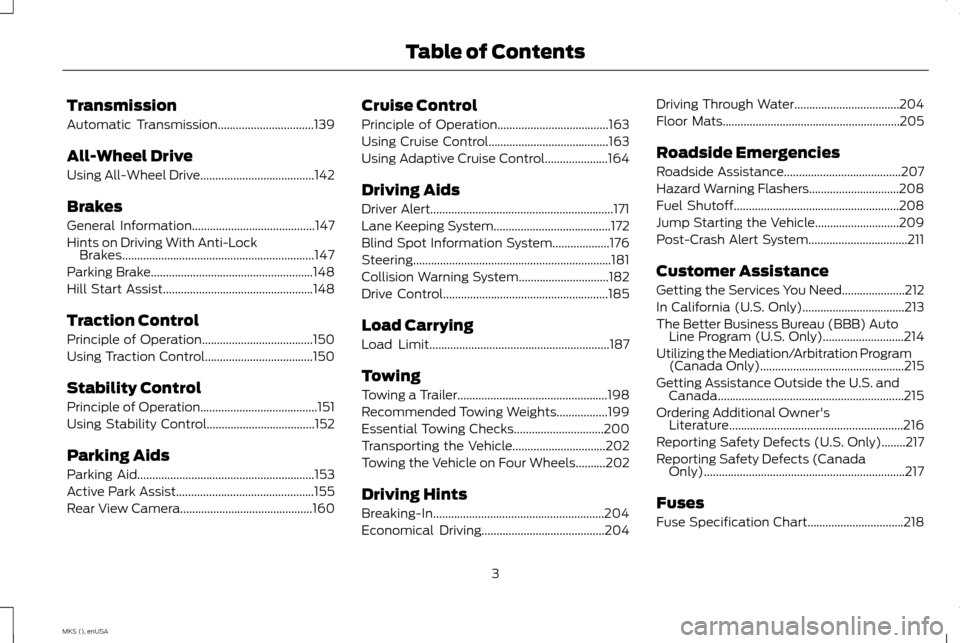
Transmission
Automatic Transmission................................139
All-Wheel Drive
Using All-Wheel Drive
......................................142
Brakes
General Information.........................................147
Hints on Driving With Anti-Lock Brakes................................................................147
Parking Brake......................................................148
Hill Start Assist
..................................................148
Traction Control
Principle of Operation.....................................150
Using Traction Control....................................150
Stability Control
Principle of Operation.......................................151
Using Stability Control....................................152
Parking Aids
Parking Aid
...........................................................153
Active Park Assist..............................................155
Rear View Camera
............................................160 Cruise Control
Principle of Operation
.....................................163
Using Cruise Control........................................163
Using Adaptive Cruise Control
.....................164
Driving Aids
Driver Alert.............................................................171
Lane Keeping System.......................................172
Blind Spot Information System
...................176
Steering..................................................................181
Collision Warning System..............................182
Drive Control
.......................................................185
Load Carrying
Load Limit
............................................................187
Towing
Towing a Trailer..................................................198
Recommended Towing Weights.................199
Essential Towing Checks..............................200
Transporting the Vehicle...............................202
Towing the Vehicle on Four Wheels..........202
Driving Hints
Breaking-In.........................................................204
Economical Driving
.........................................204 Driving Through Water...................................204
Floor Mats...........................................................205
Roadside Emergencies
Roadside Assistance
.......................................207
Hazard Warning Flashers..............................208
Fuel Shutoff.......................................................208
Jump Starting the Vehicle............................209
Post-Crash Alert System.................................211
Customer Assistance
Getting the Services You Need.....................212
In California (U.S. Only)..................................213
The Better Business Bureau (BBB) Auto Line Program (U.S. Only)
...........................214
Utilizing the Mediation/Arbitration Program (Canada Only)
................................................215
Getting Assistance Outside the U.S. and Canada..............................................................215
Ordering Additional Owner's Literature..........................................................216
Reporting Safety Defects (U.S. Only)........217
Reporting Safety Defects (Canada Only)...................................................................217
Fuses
Fuse Specification Chart
................................218
3
MKS (), enUSA Table of Contents
Page 145 of 424
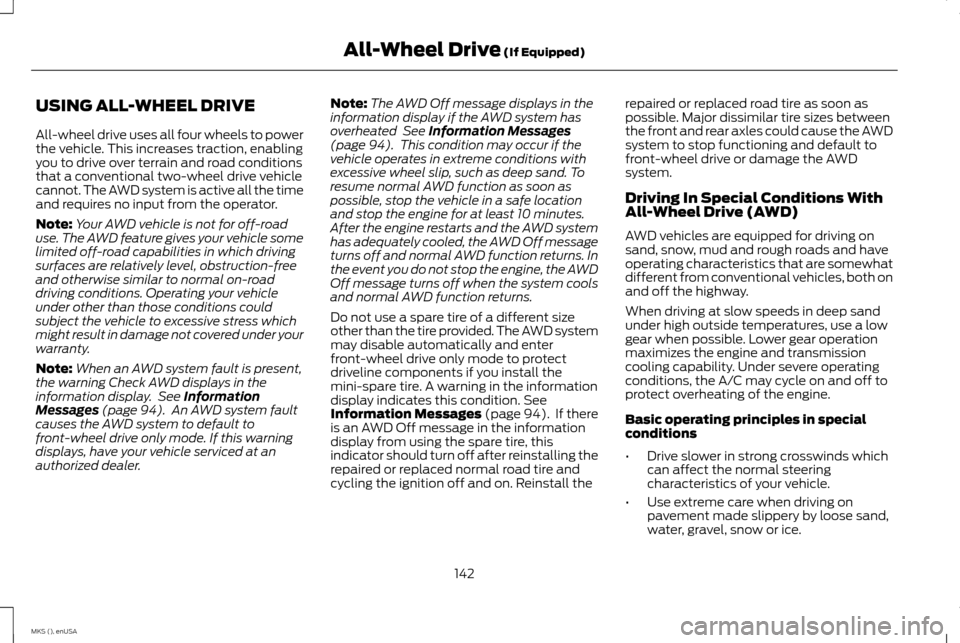
USING ALL-WHEEL DRIVE
All-wheel drive uses all four wheels to power
the vehicle. This increases traction, enabling
you to drive over terrain and road conditions
that a conventional two-wheel drive vehicle
cannot. The AWD system is active all the time
and requires no input from the operator.
Note:
Your AWD vehicle is not for off-road
use. The AWD feature gives your vehicle some
limited off-road capabilities in which driving
surfaces are relatively level, obstruction-free
and otherwise similar to normal on-road
driving conditions. Operating your vehicle
under other than those conditions could
subject the vehicle to excessive stress which
might result in damage not covered under your
warranty.
Note: When an AWD system fault is present,
the warning Check AWD displays in the
information display. See Information
Messages (page 94). An AWD system fault
causes the AWD system to default to
front-wheel drive only mode. If this warning
displays, have your vehicle serviced at an
authorized dealer. Note:
The AWD Off message displays in the
information display if the AWD system has
overheated
See Information Messages
(page 94). This condition may occur if the
vehicle operates in extreme conditions with
excessive wheel slip, such as deep sand. To
resume normal AWD function as soon as
possible, stop the vehicle in a safe location
and stop the engine for at least 10 minutes.
After the engine restarts and the AWD system
has adequately cooled, the AWD Off message
turns off and normal AWD function returns. In
the event you do not stop the engine, the AWD
Off message turns off when the system cools
and normal AWD function returns.
Do not use a spare tire of a different size
other than the tire provided. The AWD system
may disable automatically and enter
front-wheel drive only mode to protect
driveline components if you install the
mini-spare tire. A warning in the information
display indicates this condition.
See
Information Messages (page 94). If there
is an AWD Off message in the information
display from using the spare tire, this
indicator should turn off after reinstalling the
repaired or replaced normal road tire and
cycling the ignition off and on. Reinstall the repaired or replaced road tire as soon as
possible. Major dissimilar tire sizes between
the front and rear axles could cause the AWD
system to stop functioning and default to
front-wheel drive or damage the AWD
system.
Driving In Special Conditions With
All-Wheel Drive (AWD)
AWD vehicles are equipped for driving on
sand, snow, mud and rough roads and have
operating characteristics that are somewhat
different from conventional vehicles, both on
and off the highway.
When driving at slow speeds in deep sand
under high outside temperatures, use a low
gear when possible. Lower gear operation
maximizes the engine and transmission
cooling capability. Under severe operating
conditions, the A/C may cycle on and off to
protect overheating of the engine.
Basic operating principles in special
conditions
•
Drive slower in strong crosswinds which
can affect the normal steering
characteristics of your vehicle.
• Use extreme care when driving on
pavement made slippery by loose sand,
water, gravel, snow or ice.
142
MKS (), enUSA All-Wheel Drive
(If Equipped)
Page 147 of 424

steering, acceleration or braking which
could result in an increased risk of loss of
vehicle control, vehicle rollover and/or
personal injury. Use all available road
surface to return the vehicle to a safe
direction of travel.
• In the event of an emergency stop, avoid
skidding the tires and do not attempt any
sharp steering wheel movements.
• If the vehicle goes from one type of
surface to another (i.e., from concrete to
gravel) the way the vehicle responds to
a maneuver changes (steering,
acceleration or braking). Again, avoid
these abrupt inputs.
Sand
When driving over sand, try to keep all four
wheels on the most solid area of the trail.
Avoid reducing the tire pressures but shift to
a lower gear and drive steadily through the
terrain. Apply the accelerator slowly and
avoid excessive wheel slip.
Do not drive your vehicle in deep sand for an
extended period of time. This could cause
the AWD system to overheat and default to
front-wheel drive. If this occurs AWD Off
displays in the Information Display. To
resume normal AWD function as soon as
possible, stop the vehicle in a safe location and stop the engine for at least 10 minutes.
After the engine restarts and the AWD
system has adequately cooled, the AWD Off
message turns off and normal AWD function
returns. In the event you do not stop the
engine, the AWD Off message turns off when
the system cools and normal AWD function
returns.
When driving at slow speeds in deep sand
under high outside temperatures, use a low
gear when possible. Low gear operation
maximizes the engine and transmission
cooling capability. Under severe operating
conditions, the A/C may cycle on and off to
protect overheating of the engine.
Avoid excessive speed because vehicle
momentum can work against you and cause
the vehicle to become stuck to the point that
assistance may be required from another
vehicle. Remember, you may be able to back
out the way you came if you proceed with
caution.
Mud and Water
If you must drive through high water, drive
slowly. Traction or brake capability may be
limited.
When driving through water, determine the
depth; avoid water higher than the bottom
of the wheel rims (for cars) or the bottom of
the hubs (for trucks) (if possible) and
proceed slowly. If the ignition system gets
wet, the vehicle may stall.
Once through water, always try the brakes.
Wet brakes do not stop the vehicle as
effectively as dry brakes. Drying improves
when you move your vehicle slowly while
applying light pressure on the brake pedal.
144
MKS (), enUSA All-Wheel Drive (If Equipped)E142667
Page 149 of 424

Your vehicle has anti-lock brakes, therefore
apply the brakes steadily. Do not
“pump” the
brakes.
Driving on Snow and Ice WARNING
If you are driving in slippery conditions
that require tire chains or cables, then
it is critical that you drive cautiously.
Keep speeds down, allow for longer stopping
distances and avoid aggressive steering to
reduce the chances of a loss of vehicle
control which can lead to serious injury or
death. If the rear end of the vehicle slides
while cornering, steer in the direction of the
slide until you regain control of the vehicle. Note:
Excessive tire slippage can cause
transmission damage.
AWD vehicles have advantages over 2WD
vehicles in snow and ice but can skid like any
other vehicle.
Should you start to slide while driving on
snowy or icy roads, turn the steering wheel
in the direction of the slide until you regain
control. Avoid sudden applications of power and
quick changes of direction on snow and ice.
Apply the accelerator slowly and steadily
when starting from a full stop.
Avoid sudden braking as well. Although an
AWD vehicle may accelerate better than a
two-wheel drive vehicle in snow and ice, it
does not stop any faster, because as in other
vehicles, braking occurs at all four wheels.
Do not become overconfident as to road
conditions.
Make sure you allow sufficient distance
between you and other vehicles for stopping.
Drive slower than usual and consider using
one of the lower gears. In emergency
stopping situations, apply the brake steadily.
Since your vehicle is equipped with a four
wheel (ABS), do not
“pump” the brakes. See
Hints on Driving With Anti-Lock Brakes
(page 147). Maintenance and Modifications
The suspension and steering systems on your
vehicle provide predictable performance
whether loaded or empty and durable load
carrying capability. For this reason, Ford
Motor Company strongly recommends that
you do not make modifications such as
adding or removing parts (such as lowering
kits or stabilizer bars) or by using
replacement parts not equivalent to the
original factory equipment.
Any modifications to a vehicle that raise the
center of gravity can make it more likely the
vehicle will rollover as a result of a loss of
control. Ford Motor Company recommends
you use caution with any vehicle equipped
with a high load or device (such as ladder or
luggage racks).
Failure to maintain your vehicle properly may
void the warranty, increase your repair cost,
reduce vehicle performance and operational
capabilities and adversely affect driver and
passenger safety. If the vehicle experiences
off-highway use, check the vehicle chassis
components more frequently.
146
MKS (), enUSA All-Wheel Drive
(If Equipped)
Page 167 of 424
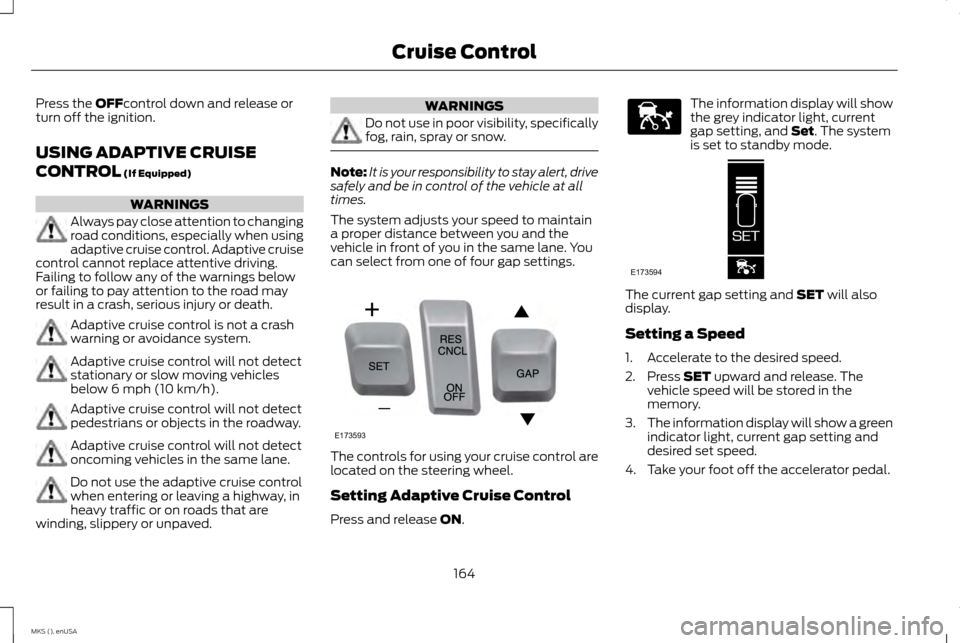
Press the OFFcontrol down and release or
turn off the ignition.
USING ADAPTIVE CRUISE
CONTROL
(If Equipped) WARNINGS
Always pay close attention to changing
road conditions, especially when using
adaptive cruise control. Adaptive cruise
control cannot replace attentive driving.
Failing to follow any of the warnings below
or failing to pay attention to the road may
result in a crash, serious injury or death. Adaptive cruise control is not a crash
warning or avoidance system.
Adaptive cruise control will not detect
stationary or slow moving vehicles
below 6 mph (10 km/h).
Adaptive cruise control will not detect
pedestrians or objects in the roadway.
Adaptive cruise control will not detect
oncoming vehicles in the same lane.
Do not use the adaptive cruise control
when entering or leaving a highway, in
heavy traffic or on roads that are
winding, slippery or unpaved. WARNINGS
Do not use in poor visibility, specifically
fog, rain, spray or snow.
Note:
It is your responsibility to stay alert, drive
safely and be in control of the vehicle at all
times.
The system adjusts your speed to maintain
a proper distance between you and the
vehicle in front of you in the same lane. You
can select from one of four gap settings. The controls for using your cruise control are
located on the steering wheel.
Setting Adaptive Cruise Control
Press and release
ON. The information display will show
the grey indicator light, current
gap setting, and
Set. The system
is set to standby mode. The current gap setting and
SET will also
display.
Setting a Speed
1. Accelerate to the desired speed.
2. Press
SET upward and release. The
vehicle speed will be stored in the
memory.
3. The information display will show a green
indicator light, current gap setting and
desired set speed.
4. Take your foot off the accelerator pedal.
164
MKS (), enUSA Cruise ControlE173593 E144529 E173594
Page 205 of 424

TRANSPORTING THE VEHICLE If you need to have your vehicle towed,
contact a professional towing service or, if
you are a member of a roadside assistance
program, your roadside assistance service
provider.
We recommend the use of a wheel lift and
dollies or flatbed equipment to tow your
vehicle. Do not tow with a slingbelt. Ford
Motor Company has not approved a slingbelt
towing procedure. Vehicle damage may occur
if towed incorrectly, or by any other means.
Ford Motor Company produces a towing
manual for all authorized tow truck operators.
Have your tow truck operator refer to this
manual for proper hook-up and towing
procedures for your vehicle.
It is acceptable to have your front-wheel drive
vehicle towed from the front if using proper
wheel lift equipment to raise the front wheels
off the ground. When towing in this manner,
the rear wheels can remain on the ground.
Front-wheel drive vehicles must have the
front wheels placed on a tow dolly when
towing your vehicle from the rear using wheel
lift equipment. This prevents damage to the
transmission.
Towing an all-wheel drive vehicle requires
that all wheels be off the ground, such as
using a wheel lift and dollies or flatbed
equipment. This prevents damage to the
transmission, all-wheel drive system and
vehicle.
TOWING THE VEHICLE ON FOUR
WHEELS
Emergency Towing
You can flat-tow (all wheels on the ground,
regardless of the powertrain/transmission
configuration) your disabled vehicle (without
access to wheel dollies, car-hauling trailer,
or flatbed transport vehicle) under the
following conditions:
•
Your vehicle is facing forward so you tow
it in a forward direction.
• You place the transmission in neutral (N).
If you cannot place the transmission in
neutral (N), you may need to override it.
See Transmission (page 139).
• Maximum speed is 35 mph (56 km/h).
• Maximum distance is 50 miles (80
kilometers).
202
MKS (), enUSA TowingE143886
Page 206 of 424
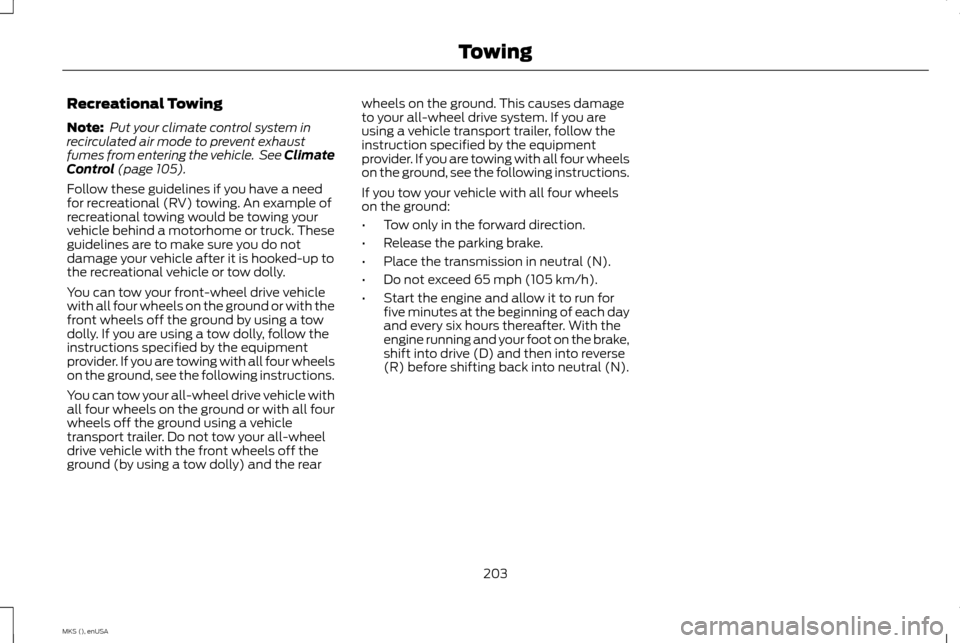
Recreational Towing
Note:
Put your climate control system in
recirculated air mode to prevent exhaust
fumes from entering the vehicle. See Climate
Control (page 105).
Follow these guidelines if you have a need
for recreational (RV) towing. An example of
recreational towing would be towing your
vehicle behind a motorhome or truck. These
guidelines are to make sure you do not
damage your vehicle after it is hooked-up to
the recreational vehicle or tow dolly.
You can tow your front-wheel drive vehicle
with all four wheels on the ground or with the
front wheels off the ground by using a tow
dolly. If you are using a tow dolly, follow the
instructions specified by the equipment
provider. If you are towing with all four wheels
on the ground, see the following instructions.
You can tow your all-wheel drive vehicle with
all four wheels on the ground or with all four
wheels off the ground using a vehicle
transport trailer. Do not tow your all-wheel
drive vehicle with the front wheels off the
ground (by using a tow dolly) and the rear wheels on the ground. This causes damage
to your all-wheel drive system. If you are
using a vehicle transport trailer, follow the
instruction specified by the equipment
provider. If you are towing with all four wheels
on the ground, see the following instructions.
If you tow your vehicle with all four wheels
on the ground:
•
Tow only in the forward direction.
• Release the parking brake.
• Place the transmission in neutral (N).
• Do not exceed 65 mph (105 km/h).
• Start the engine and allow it to run for
five minutes at the beginning of each day
and every six hours thereafter. With the
engine running and your foot on the brake,
shift into drive (D) and then into reverse
(R) before shifting back into neutral (N).
203
MKS (), enUSA Towing
Page 279 of 424
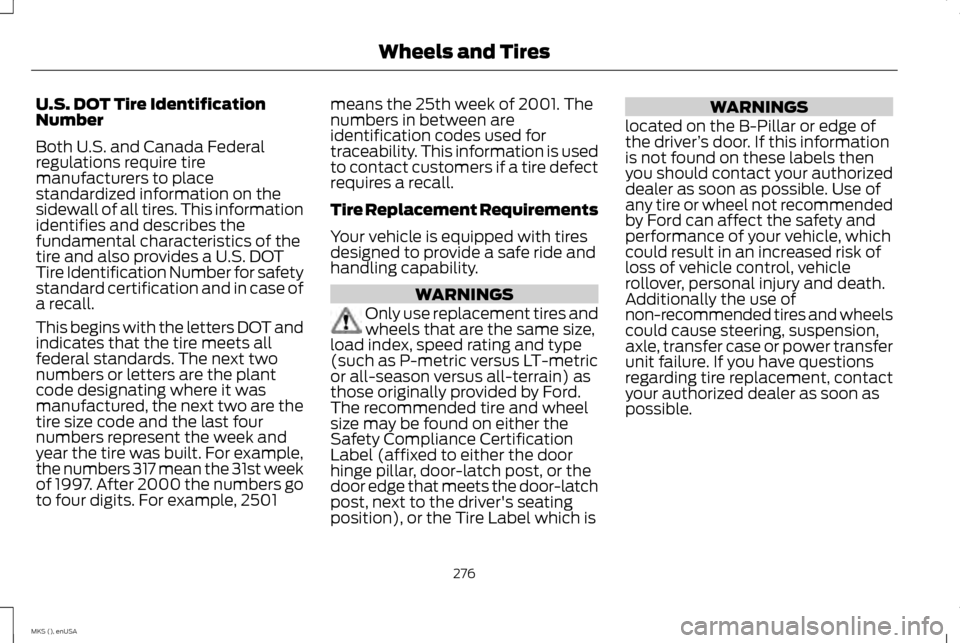
U.S. DOT Tire Identification
Number
Both U.S. and Canada Federal
regulations require tire
manufacturers to place
standardized information on the
sidewall of all tires. This information
identifies and describes the
fundamental characteristics of the
tire and also provides a U.S. DOT
Tire Identification Number for safety
standard certification and in case of
a recall.
This begins with the letters DOT and
indicates that the tire meets all
federal standards. The next two
numbers or letters are the plant
code designating where it was
manufactured, the next two are the
tire size code and the last four
numbers represent the week and
year the tire was built. For example,
the numbers 317 mean the 31st week
of 1997. After 2000 the numbers go
to four digits. For example, 2501
means the 25th week of 2001. The
numbers in between are
identification codes used for
traceability. This information is used
to contact customers if a tire defect
requires a recall.
Tire Replacement Requirements
Your vehicle is equipped with tires
designed to provide a safe ride and
handling capability.
WARNINGS
Only use replacement tires and
wheels that are the same size,
load index, speed rating and type
(such as P-metric versus LT-metric
or all-season versus all-terrain) as
those originally provided by Ford.
The recommended tire and wheel
size may be found on either the
Safety Compliance Certification
Label (affixed to either the door
hinge pillar, door-latch post, or the
door edge that meets the door-latch
post, next to the driver's seating
position), or the Tire Label which is WARNINGS
located on the B-Pillar or edge of
the driver ’s door. If this information
is not found on these labels then
you should contact your authorized
dealer as soon as possible. Use of
any tire or wheel not recommended
by Ford can affect the safety and
performance of your vehicle, which
could result in an increased risk of
loss of vehicle control, vehicle
rollover, personal injury and death.
Additionally the use of
non-recommended tires and wheels
could cause steering, suspension,
axle, transfer case or power transfer
unit failure. If you have questions
regarding tire replacement, contact
your authorized dealer as soon as
possible.
276
MKS (), enUSA Wheels and Tires
Page 281 of 424
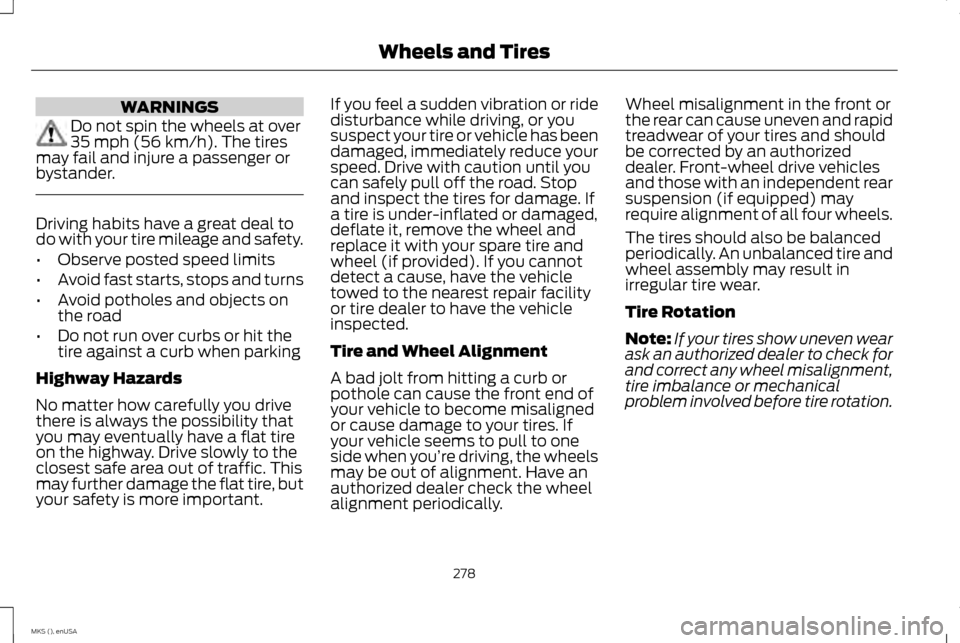
WARNINGS
Do not spin the wheels at over
35 mph (56 km/h). The tires
may fail and injure a passenger or
bystander. Driving habits have a great deal to
do with your tire mileage and safety.
•
Observe posted speed limits
• Avoid fast starts, stops and turns
• Avoid potholes and objects on
the road
• Do not run over curbs or hit the
tire against a curb when parking
Highway Hazards
No matter how carefully you drive
there is always the possibility that
you may eventually have a flat tire
on the highway. Drive slowly to the
closest safe area out of traffic. This
may further damage the flat tire, but
your safety is more important. If you feel a sudden vibration or ride
disturbance while driving, or you
suspect your tire or vehicle has been
damaged, immediately reduce your
speed. Drive with caution until you
can safely pull off the road. Stop
and inspect the tires for damage. If
a tire is under-inflated or damaged,
deflate it, remove the wheel and
replace it with your spare tire and
wheel (if provided). If you cannot
detect a cause, have the vehicle
towed to the nearest repair facility
or tire dealer to have the vehicle
inspected.
Tire and Wheel Alignment
A bad jolt from hitting a curb or
pothole can cause the front end of
your vehicle to become misaligned
or cause damage to your tires. If
your vehicle seems to pull to one
side when you’re driving, the wheels
may be out of alignment. Have an
authorized dealer check the wheel
alignment periodically.Wheel misalignment in the front or
the rear can cause uneven and rapid
treadwear of your tires and should
be corrected by an authorized
dealer. Front-wheel drive vehicles
and those with an independent rear
suspension (if equipped) may
require alignment of all four wheels.
The tires should also be balanced
periodically. An unbalanced tire and
wheel assembly may result in
irregular tire wear.
Tire Rotation
Note:
If your tires show uneven wear
ask an authorized dealer to check for
and correct any wheel misalignment,
tire imbalance or mechanical
problem involved before tire rotation.
278
MKS (), enUSA Wheels and Tires
Page 282 of 424
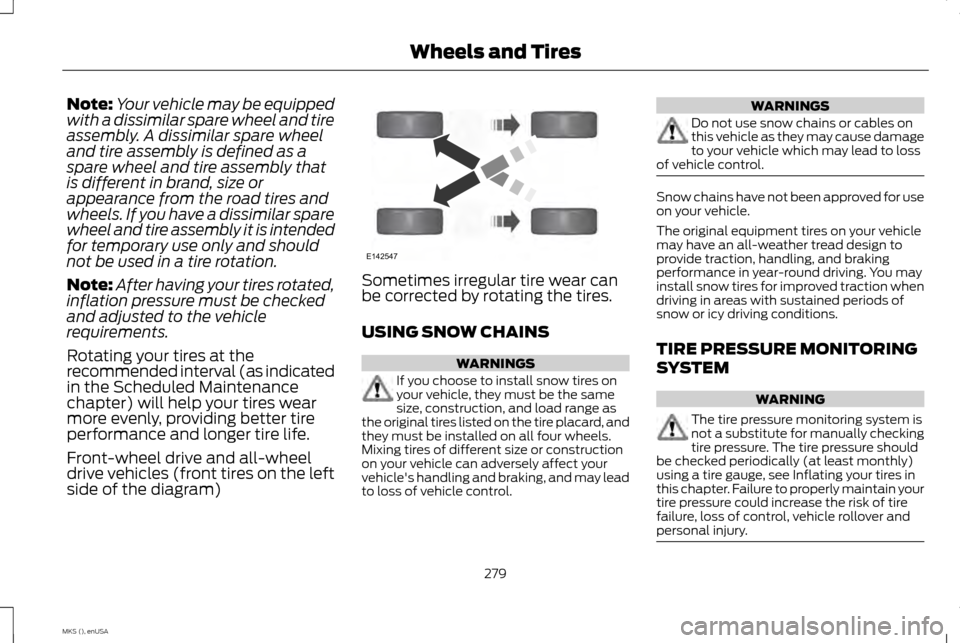
Note:
Your vehicle may be equipped
with a dissimilar spare wheel and tire
assembly. A dissimilar spare wheel
and tire assembly is defined as a
spare wheel and tire assembly that
is different in brand, size or
appearance from the road tires and
wheels. If you have a dissimilar spare
wheel and tire assembly it is intended
for temporary use only and should
not be used in a tire rotation.
Note: After having your tires rotated,
inflation pressure must be checked
and adjusted to the vehicle
requirements.
Rotating your tires at the
recommended interval (as indicated
in the Scheduled Maintenance
chapter) will help your tires wear
more evenly, providing better tire
performance and longer tire life.
Front-wheel drive and all-wheel
drive vehicles (front tires on the left
side of the diagram) Sometimes irregular tire wear can
be corrected by rotating the tires.
USING SNOW CHAINS
WARNINGS
If you choose to install snow tires on
your vehicle, they must be the same
size, construction, and load range as
the original tires listed on the tire placard, and
they must be installed on all four wheels.
Mixing tires of different size or construction
on your vehicle can adversely affect your
vehicle's handling and braking, and may lead
to loss of vehicle control. WARNINGS
Do not use snow chains or cables on
this vehicle as they may cause damage
to your vehicle which may lead to loss
of vehicle control. Snow chains have not been approved for use
on your vehicle.
The original equipment tires on your vehicle
may have an all-weather tread design to
provide traction, handling, and braking
performance in year-round driving. You may
install snow tires for improved traction when
driving in areas with sustained periods of
snow or icy driving conditions.
TIRE PRESSURE MONITORING
SYSTEM
WARNING
The tire pressure monitoring system is
not a substitute for manually checking
tire pressure. The tire pressure should
be checked periodically (at least monthly)
using a tire gauge, see Inflating your tires in
this chapter. Failure to properly maintain your
tire pressure could increase the risk of tire
failure, loss of control, vehicle rollover and
personal injury. 279
MKS (), enUSA Wheels and TiresE142547